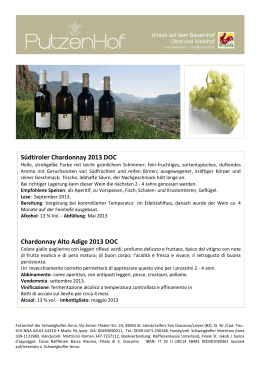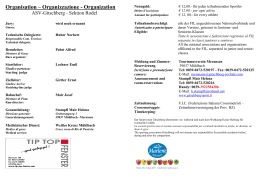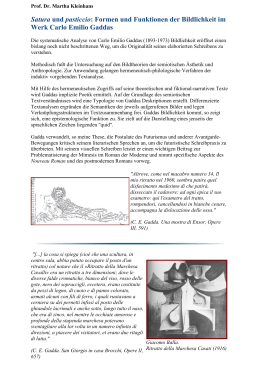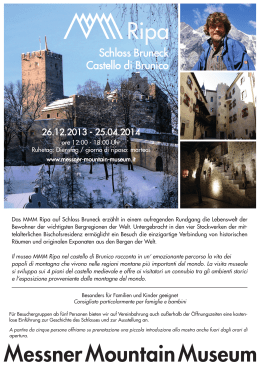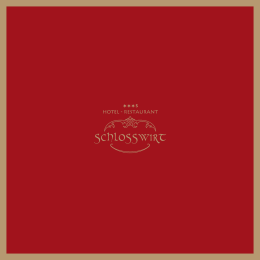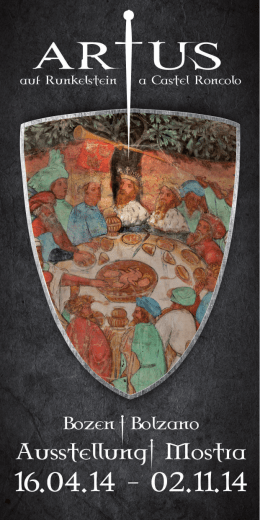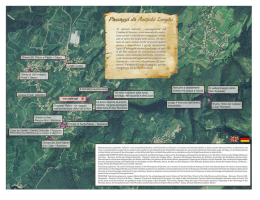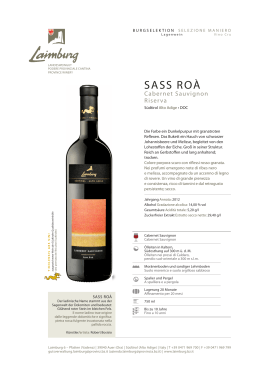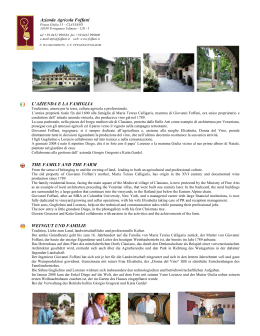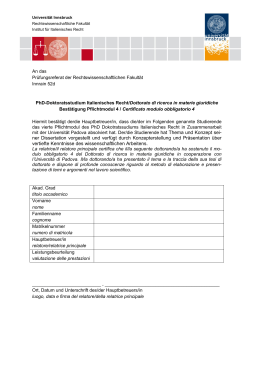MUSICA ITALIANA Gianandrea Noseda conducts THE ITALIAN INTERMEZZO MUSIC WITHOUT WORDS Alfredo Catalani © Lebrecht Music & Arts Photo Library The Italian Intermezzo Music without Words Francesco Cilea (1866 –1950) Adriana Lecouvreur 1 Intermezzo, Act II 2:46 Giacomo Puccini (1858 –1924) Manon Lescaut 2 Intermezzo, Act III 4:56 Alfredo Catalani (1854 –1893) Loreley 3 Dance of the Water Nymphs 5:51 Giacomo Puccini Suor Angelica 4 Intermezzo 3:36 3 Umberto Giordano (1867 –1948) Siberia 5 3:59 Amilcare Ponchielli (1834 –1886) La Gioconda 6 Dance of the Hours 8:54 Pietro Mascagni (1863 –1945) L’Amico Fritz 7 Intermezzo 4:53 Giuseppe Verdi (1813 –1901) La traviata 8 Prelude to Act III 3:21 Giacomo Puccini Edgar 10 9 4 Prelude to Act II Prelude to Act I Prelude to Act III 4:26 3:57 Alfredo Catalani La Wally 12 Prelude to Act III Intermezzo Prelude to Act IV Intermezzo Ermanno Wolf-Ferrari (1876–1948) 11 13 I Quattro Rusteghi Intermezzo Intermezzo 14 4:29 Ruggero Leoncavallo (1857–1919) I Pagliacci Intermezzo Umberto Giordano Fedora Intermezzo Act II 16 3:25 Jewels of The Madonna 15 4:00 6:31 3:30 2:25 TT 72:32 BBC Philharmonic Yuri Torchinsky leader Gianandrea Noseda 5 The Italian Intermezzo: Music without Words From the beginning of Italian opera with Monteverdi and Cavalli in the seventeenth century, music had the first word whether in simple overtures, entr’actes or ballets. However, it was the words that the audience had come to hear first and then the music. And the earliest theorists and practitioners all stress the primacy of poetry over the music that accompanied it. This too was the ‘rule’ that the bel canto traditions paid court to right through the eighteenth century and into the Romantic age. Rossini and then Donizetti and Bellini may have stretched the form of opera as far as possible to encompass a new sense of the dramatic on stage, but first the words and then the music. So how do we explain the appearance of the orchestral intermezzo between scenes in Italian opera in the middle of the nineteenth century or a prelude before an act that isn’t really a second or third overture to the work? Giuseppe Verdi La traviata, Prelude to Act III. There’s a clue perhaps in Verdi’s haunting Prelude to Act 3 of La traviata. Those tremulous strings take us straight to the sick room where Violetta is dying. The regular beat of the 6 pizzicato basses tell us her time is ticking away while, when the woodwinds tiptoe in, they to remind us of her sacrifice in giving up Alfredo so that his sister might make a socially suitable marriage. This music says more than several pages of libretto might. If Verdi is exploring the expressive power of the orchestra he’s also marking the possibilities of music to not only paint the scene for an audience but to comment on the action too. We are only a step away from Wagner where the drama is in the orchestra quite as much as on stage. Later nineteenth century Italian composers were divided in their reactions to Wagner’s music dramas. Some, like their French contemporaries fell hopelessly under the spell of the Wizard of Bayreuth while others kept their distance, proclaiming the virtues of their own native musical traditions. But while they may not have wanted to write the ‘music of the future’, the idea of playing out the drama in the pit was irresistible. Amilcare Ponchielli La Gioconda, Dance of the Hours For some composers music without words came into its own in the traditional ballet inserted into an opera. Perhaps the bestknown Italian opera ballet is the “Dance of the Hours” from Amilcare Ponchielli’s opera La Gioconda which was first performed in 1876. The ballet which comes in the final act of the opera is more than an opportunity for fleet footed choreography, the music mirrors the passing of dawn to day and day to night and so dramatises the conflict between darkness and light in a work where this simple duality reflects the choice between good and evil. Giacomo Puccini Edgar, Preludes to Act I & III /Suor Angelica, Intermezzo / Manon Lescaut, Intermezzo It was Amilcare Ponchielli to whom Giacomo Puccini looked when searching for an operatic role model. Puccini had studied composition with the older composer in Milan in the 1880s and you can hear it in much of the score for Puccini’s second opera, Edgar, a disaster when it was first produced at La Scala in 1889. This story of a hero Edgar caught between two women, the wicked gypsy Tigrana and the virginal Fidelia set in medieval Flanders has not fared much better in a revised three act version. But the Prelude to Act 1 of Edgar has that orchestral delicacy and those spreading chords that will become this composer’s highly personal signature. The Prelude to Act 2, a funeral march for Edgar who has fallen in battle has a gloriously long lush melody that is unmistakeably Puccinian. It’s a small wonder that Toscanini conducted it at the composer’s own funeral in 1924. It was Manon Lescaut Puccini’s third opera that made his name and his reputation when it was given its first performances at the Teatro Regio in Turin in 1893. Wagner has joined Ponchielli in the composer’s musical armoury with a Tristan like yearning duet for strings opening the Act 3 Intermezzo. No doubts here that it’s Manon and her devoted lover Des Grieux on the road to Le Havre, from where she will be shipped out to a penal colony in Louisiana. The orchestra is both telling the story and adding its own sad comment on Manon’s fate. The Intermezzo to Puccini’s opera Suor Angelica, the second part of Il trittico, the composer’s trio of one act operas which were given their first performance at the Met in New York in 1918, is a model of orchestral economy, capturing Angelica’s unhappy mood and hinting at the holiness of the convent where she has been immured after the birth of her illegitimate child. Pietro Mascagni L’Amico Fritz, Intermezzo Ruggero Leoncavallo I Pagliacci, Intermezzo The composers Pietro Mascagni and Ruggero 7 Leoncavallo are as firmly yoked together in the popular imagination as their two one-act operas Cav and Pag, Cavalleria rusticana and Pagliacci. While both subscribed to the ideals of Verismo, to dragging the real world onto the operatic stage seasoned with heavy doses of melodrama, they were in reality their own men musically. The Intermezzo that divides the two scenes of Pagliacci is distinctly Wagnerian. Dark descending chords seem to hint at a funeral march for Siegfried while high strings suggest Brünnhilde awakening on her fiery mountain top but then the orchestra whispers the melody of “Vesti la giubba”, perhaps the opera’s best known aria and we swing into a lush melody that will raise the curtain on the clowns grisly tragedy, with the jealous Canio murdering his wife Nedda and her lover Silvio on stage. This is emotional scene painting of a high order. Neither Leoncavallo nor Mascagni ever quite emulated the popular success of Cav and Pag although not for want of trying. L’amico Fritz, written immediately after Cavalleria rusticana in 1890/91 is perhaps Mascagni’s ‘other opera’, though some carry a torch for Iris. L’amico Fritz, a pastoral tale set in an improbable Alsace, has by now the almost obligatory Intermezzo. Verdi declared the libretto to be ‘the worst ... I’ve ever seen’, 8 but Mascagni knew how to rack up real drama in the orchestra. Francesco Cilea Adriana Lecouvreur, Intermezzo, Act II Umberto Giordano Siberia, Prelude to Act II/ Fedora, Intermezzo, Act II It’s strange that what survives in performance from so many Italian operas from the end of the nineteenth and the early years of the twentieth century are the orchestral interludes that often commented on the action rather than carried the story itself. However, in the hands of a craftsman these intermezzi can be fully rounded miniature dramas. Umberto Giordano and Francesco Cilea both of whom lived on until 1948 and 1950 respectively are such craftsmen. The Prelude to Act 2 from Giordano’s Siberia (1903), a very Italian excursion to Imperial Russia from a St Petersburg palace to a labour camp in Siberia, has savage winter wind lashing the orchestra who summon up dark angular chords that scream of Russian ‘fate’ before we hear a wintry dawn rise over the prisoners. Fedora (1898) has recently returned to the repertoire, and it would be churlish not to welcome a piece with an Act 2 Prelude that includes some sumptuous writing for strings and a winning part for the harp as a simple melody threads its way around the orchestra. Is this Fedora musing on the death of her fiancé on her way from St Petersburg to Paris in search of revenges? Francesco Cilea’s name has been kept in the repertoire by just one work, Adriana Lecouvreur (1902), with a pearl of a leading role for a great dramatic soprano, an eighteenth century French actress who dies after smelling a posy of violets that have been poisoned by a rival for her lover. The plot is labyrinthine, but the Intermezzo in Act 2 is perfectly straightforward as Adriana attempts to help her rival to escape. You can almost hear the lights being extinguished as they prepare for the flight while the plaintive melody, passed from a solo oboe to the strings, puts Adriana at the centre of the action. Alfredo Catalani La Wally, Act III Intermezzo/ Act IV Intermezzo/ Loreley, Dance of the Water Nymphs History has judged Alfredo Catalani to be another one opera composer, but La Wally, first performed at La Scala in 1892, is full of winning music and orchestrally nowhere more so than in the Preludes to Acts 3 and 4 of the opera. For a composer who kills his heroine in the grand style by her jumping into a Tyrolean avalanche these Preludes are anything but melodramatic, as finely worked as Austrian lace. Catalani composed Loreley over a decade before La Wally, and the Dance of the Water Nymphs is the only part of the score that is still in the repertoire. A curiosity too: an Italian borrowing of a German legend. This is music that reminds us that Catalani belonged to the generation that came immediately after Verdi and not the later Verismo generation. Indeed musically, Alfredo Catalani inclined more towards Germany than his native Italy. Ermanno Wolf-Ferrari I Quattro Rusteghi, Intermezzo/ Jewels of the Madonna, Intermezzo At the beginning of the twentieth century Ermanno Wolf-Ferrari, the son of a German father and an Italian mother also found himself culturally divided. Success in Italy eluded him, but Germany welcomed his operas, which are wittily neo-classical but never averse to exploiting a good melody. The Intermezzo from his three act comedy I Quarto Rusteghi is a happy combination of both impulses. I gioielli della Madonna on the other hand seems to look backwards to the emotional blood and thunder of Verismo opera. Wolf-Ferrari’s contemporaries were surprised at this turn in his music. Was he hoping to court an Italian audience who had 9 neglected him with a tale of Neapolitan jealousy and revenge? However, the Intermezzo from the opera is anything but a pastiche and beautifully crafted. A fitting last word on a recording that has witnessed the rise of a new voice in Italian opera, the orchestra. © 2011 Christopher Cook Widely recognised as one of Britain’s finest orchestras, the BBC Philharmonic has built an international reputation for outstanding quality and committed performances over a wide-ranging repertoire. It has its own studio in Manchester where it records for BBC Radio 3 and Chandos. As well as offering an annual season in Manchester’s Bridgewater Hall, the Orchestra performs across the North West of England and at the BBC Proms as well as being regularly invited to major cities and festivals across the world. The Orchestra’s Chief Conductor Gianandrea Noseda has been at the helm since 2002 and is also Music Director at the Teatro Regio,Torino. As a consequence of its policy of introducing new and adventurous repertoire, many great composers have worked with the Orchestra, including Berio, Penderecki, Tippett, Harrison Birtwistle, Hans Werner Henze, Mark-Anthony Turnage and Unsuk Chin. Sir Peter Maxwell Davies became 10 the Orchestra’s first Composer/Conductor in 1991 and was succeeded by James MacMillan ten years later. In 2009 the renowned Austrian composer H.K. Gruber took over the role. The BBC Philharmonic’s partnership with Salford City Council enables it to build active links with Salford and its communities ahead of its move to its new, dedicated, state-of-the-art studio at the BBC’s new home in MediaCity, Salford Quays. Gianandrea Noseda is Chief Conductor of the BBC Philharmonic, the Music Director of Teatro Regio in Turin, Principal Conductor of the Orquesta de Cadaqués and the Artistic Director of the Stresa Festival. He became the first foreign Principal Guest Conductor at the Mariinsky Theatre in St Petersburg in 1997 and has been the Principal Guest Conductor of the Rotterdam Philharmonic and the Orchestra Sinfonica Nazionale della RAI, Turin. Gianandrea Noseda’s collaboration with the BBC Philharmonic includes numerous recordings and concerts, including annual appearances at the BBC Proms and extensive international touring activity. He also appears all over the world with orchestras such as the New York Philharmonic, Pittsburgh, Chicago and Boston Symphony Orchestras, the London Symphony Orchestra, Oslo Philharmonic, NHK Symphony Orchestra, Orchestre National de France, Israel Philharmonic, Filarmonica della Scala and Santa Cecilia Orchestras. During 2010/11 he will make his first appearance with the Philadelphia Orchestra and the Orchestre de Paris. Gianandrea Noseda has conducted many operas at Teatro Regio including new productions of Don Giovanni, Salome, Thaïs, The Queen of Spades and La traviata. In the summer of 2010 he took the company to Japan and China. Gianandrea Noseda conducted the Mariinsky Theatre – both on tour and in St Petersburg in many productions of opera and ballet. In 2002 he made his Metropolitan Opera debut, returning many times since, with future projects including La traviata (2010), Lucia di Lammermoor (on tour in Japan in 2011) and Macbeth (2012). Since 2002 Gianandrea Noseda has been an exclusive artist of Chandos with a discography that includes music by Prokofiev, Karłowicz, Dvořák, Smetana, Shostakovich, Mahler, Liszt’s complete symphonic cycle, and operas and symphonies by Rachmaninoff. He has championed his compatriots through the Musica Italiana project with rarely heard works by Respighi, Dallapiccola, Wolf-Ferrari and Casella. 11 Das italienische Intermezzo: Musik ohne Worte Vom Anbeginn der italienischen Oper im siebzehnten Jahrhundert mit Monteverdi und Cavalli hatte die Musik zuerst das Sagen, sei es in einfachen Ouvertüren, in Zwischenaktoder in Ballettmusiken. Das Publikum jedoch war es gewohnt, zunächst auf die Worte zu achten und erst dann auf die Musik. Und auch alle frühen Theoretiker und Praktiker betonen die Vorherrschaft der Dichtung gegenüber der sie begleitenden Musik. Dieser “Regel” folgten auch die BelcantoTraditionen während des gesamten achtzehnten Jahrhunderts bis ins Zeitalter der Romantik. Rossini und nach ihm Donizetti und Bellini mögen zwar die Form der Oper soweit wie möglich erweitert haben, um einem neuen Sinn für das Dramatische auf der Bühne Rechnung zu tragen, doch auch hier kam zuerst das Wort und dann die Musik. Wie erklären wir also das Auftauchen des orchestralen Intermezzo zwischen einzelnen Szenen der italienischen Oper in der Mitte des neunzehnten Jahrhunderts oder ein Vorspiel zu einem Akt, bei dem es sich nicht eigentlich um eine zweite oder dritte Ouvertüre zu dem Werk handelt? 12 Giuseppe Verdi, La traviata, Vorspiel zu Akt III Eine mögliche Erklärung deutet sich in Verdis unvergesslichem Vorspiel zu Akt III von La traviata an. Dessen tremolierende Streicherklänge versetzen uns geradewegs in das Krankenzimmer, in dem Violetta im Sterben liegt. Der regelmäßige Schlag der Pizzicato-Bässe teilt uns das Ticken der ihr noch verbleibenden Zeit mit, während die sich ihnen auf Zehenspitzen hinzugesellenden Holzbläser uns an ihr Opfer erinnern, als sie Alfredo aufgab, damit seine Schwester eine gesellschaftlich angemessene Ehe eingehen könne. Diese Musik teilt uns mehr mit, als mehrere Seiten eines Librettos in Worte fassen könnten. Indem Verdi hier das expressive Potential des Orchesters auslotet, stellt er zugleich die Fähigkeit der Musik unter Beweis, nicht nur den passenden Hintergrund für die Zuhörer zu liefern, sondern zugleich auch die Handlung zu kommentieren. Wir sind hier nur einen Schritt von Wagner entfernt, bei dem das Drama sich ebenso sehr im Orchester entfaltet wie auf der Bühne. Die italienischen Komponisten des späteren neunzehnten Jahrhunderts waren bezüglich Wagners Musikdramen geteilter Meinung. Einige gerieten wie ihre französischen Zeitgenossen in den Bann des Bayreuther Zauberers, während andere Distanz wahrten und die Tugenden ihrer eigenen musikalischen Traditionen propagierten. Doch während sie eher abgeneigt waren, selbst die “Musik der Zukunft” zu schreiben, erwies sich der Gedanke als unwiderstehlich, das Drama in den Orchestergraben zu verlegen. Amilcare Ponchielli, La Gioconda, Stundentanz Für einige Komponisten gewann die Musik ihre von Worten unabhängige Eigenständigkeit in den traditionell in eine Oper eingefügten Ballettmusiken. Das vielleicht bekannteste italienische Opernballett ist der “Stundentanz” aus Amilcare Ponchiellis Oper La Gioconda, die 1876 erstaufgeführt wurde. Das Ballet, das in den letzten Akt der Oper eingebettet ist, ist weit mehr als nur eine Gelegenheit für flinkfüßige Choreographie – die Musik spiegelt den Übergang von der Dämmerung zum Tag und vom Tag zur Nacht und dramatisiert auf diese Weise den Konflikt zwischen Dunkelheit und Licht in einem Werk, in dem diese einfache Dualität die Wahl zwischen gut und böse reflektiert. Giacomo Puccini, Edgar, Vorspiele zu Akt I und III/Suor Angelica, Intermezzo / Manon Lescaut, Intermezzo Bei seiner Suche nach einem Vorbild für seine Opern wandte Giacomo Puccini sich Amilcare Ponchielli zu. Puccini hatte in den 1880er Jahren bei dem älteren Meister in Mailand Komposition studiert, und dies ist in weiten Teilen seiner zweiten Oper Edgar auch zu hören. Die Erstaufführung des Werks an der Scala im Jahre 1889 war ein Desaster. Auch in der revidierten dreiaktigen Fassung erging es dieser im mittelalterlichen Flandern angesiedelten Geschichte des Helden Edgar und seinen Verstrickungen mit der bösen Zigeunerin Tigrana und der jungfräulichen Fidelia kaum besser. Doch das Vorspiel zu Akt I von Edgar enthielt bereits die Feinheit der orchestralen Umsetzung und die weit ausgreifenden Akkorde, die sich zu dem sehr ausgeprägten Individualstil des Komponisten entwickeln sollen. Das Vorspiel zu Akt III, ein Trauermarsch für Edgar, der im Kampf gefallen ist, enthält eine wunderbar vollklingende Melodie, die bereits ganz unverwechselbarer Puccini ist. Es ist ein kleines Wunder, dass Toscanini das Stück anlässlich des Begräbnisses des Komponisten im Jahr 1924 dirigierte. Mit der Erstaufführung seiner dritten Oper, Manon Lescaut, am Turiner Teatro Regio 13 im Jahre 1893 begründete Puccini seinen Ruhm. Im Arsenal des Komponisten hatte sich Wagner zu Ponchielli gesellt, und das Intermezzo aus Akt III beginnt mit einem an Tristan gemahnenden sehnsuchtsvollen Duett für Streicher. Es besteht kein Zweifel, dass wir hier Manon und ihren ergebenen Geliebten Des Grieux auf der Straße nach Le Havre vor uns haben, von wo aus Manon per Schiff in eine Strafkolonie in Louisiana verbracht werden soll. Das Orchester erzählt ihre Geschichte und liefert zugleich seinen eigenen traurigen Kommentar zu Manons Schicksal. Das Intermezzo aus Puccinis Oper Suor Angelica, dem zweiten Teil von “Il trittico”, der Triga von einaktigen Opern aus der Feder dieses Komponisten, die 1918 an der Met in New York uraufgeführt wurden, ist ein Muster an orchestraler Ökonomie. Es fängt gekonnt Angelicas unglückliche Stimmung ein und vermittelt zugleich einen Eindruck von der Heiligkeit des Konvents, wo sie nach der Geburt ihres illegitimen Kindes eingesperrt war. Pietro Mascagni, L’amico Fritz, Intermezzo Ruggero Leoncavallo, Pagliacci, Intermezzo Die Komponisten Pietro Mascagni und Ruggero Leoncavallo werden in der populären Vorstellung ähnlich eng miteinander assoziiert 14 wie ihre beiden einaktigen Opern Cav und Pag, Cavalleria rusticana und Pagliacci. Während beide sich den Idealen des Verismo verschrieben haben, die reale Welt auf die Opernbühne zu zerren und sie dabei noch mit großzügigen Dosen von Melodrama zu würzen, waren sie in musikalischer Hinsicht eigentlich sehr unterschiedlich. Das Intermezzo, das die beiden Szenen der Pagliacci voneinander trennt, ist deutlich Wagner verpflichtet. Dunkle absteigende Akkorde scheinen einen Trauermarsch für Siegfried anzudeuten, während hohe Streicher an die auf ihrem Feuerberg erwachende Brünnhilde erinnern; doch dann wispert das Orchester die Melodie von “Vesti la giubba”, die vielleicht bekannteste Arie der Oper, und wir schwingen in eine vollklingende Melodie ein, zu der der Vorhang aufgeht und die schauerliche Tragödie des Clowns anhebt, in der der eifersüchtige Canio seine Gattin Nedda und ihren Liebhaber Silvio auf der Bühne ermordet. Das ist schon eine emotionale Bühnendarstellung erster Ordnung. Weder Leoncavallo noch Mascagni gelang trotz großer Bemühungen je wieder ein Cav und Pag vergleichbarer populärer Erfolg. L’amico Fritz entstand 1890/91 unmittelbar nach Cavalleria rusticana und ist vielleicht Mascagnis “andere Oper”, obwohl manche auch Iris favorisieren. L’amico Fritz, eine pastorale Erzählung, die in einem eher unrealistischen Elsass spielt, enthält auch wieder das inzwischen fast obligatorische Intermezzo. Verdi verurteilte das Libretto als “das schlechteste, … das mir jemals vor Augen gekommen ist”, doch Mascagni wusste genau, wie man im Orchester echtes Drama schürt. Francesco Cilea, Adriana Lecouvreur, Intermezzo aus Akt II Umberto Giordano, Siberia, Vorspiel zu Akt II/ Fedora, Intermezzo aus Akt II Es ist eigenartig, dass sich von so vielen italienischen Opern vom Ende des neunzehnten und den ersten Jahren des zwanzigsten Jahrhunderts ausgerechnet die Orchester-Zwischenspiele im Aufführungsrepertoire erhalten haben, die häufig die Handlung lediglich kommentierten, anstatt sie bewusst weiter zu entwickeln. Doch eben diese Intermezzi können in der Hand eines Meisters zu voll abgerundeten Miniaturdramen werden. Umberto Giordano und Francesco Cilea, die beide bis 1948 bzw. 1950 lebten, waren solche Meister. Das Vorspiel zu Akt II aus Giordanos Siberia (1903), eine überaus italienische Exkursion ins zaristische Russland, von einem Petersburger Palast in ein sibirisches Arbeitslager, beginnt mit ungebändigten Winterstürmen, die das Orchester beuteln; dieses beschwört dunkle kantige Akkorde herauf, die vom russischen “Schicksal” künden, bevor über den Gefangenen eine winterliche Dämmerung anbricht. Fedora (1898) wurde in jüngerer Zeit wieder ins Repertoire aufgenommen und es wäre kaum akzeptabel, ein Werk mit einem Vorspiel zum zweiten Akt zu ignorieren, das einige besonders opulente Passagen für Streicher und einen sehr einnehmenden Part für Harfe enthält und in dem eine einfache Melodie sich wie ein Faden durch das orchestrale Geschehen zieht. Soll dies eine Fedora darstellen, die auf dem Weg von Sankt Petersburg nach Paris voller Rachsucht über den Tod ihres Verlobten nachdenkt? Francesco Cileas Name ist im gängigen Repertoire seit langer Zeit mit nur einem Werk vertreten – Adriana Lecouvreur (1902), mit einer Perle von einer Starrolle für einen großen dramatischen Sopran: eine französische Schauspielerin des achtzehnten Jahrhunderts, die stirbt, nachdem sie an einem Veilchensträußchen gerochen hat, das von einer Rivalin um ihren Liebhaber vergiftet wurde. Die Handlung entwickelt sich recht labyrinthisch, doch das Intermezzo im zweiten Akt ist ausgesprochen geradlinig, indem Adriana ihrer Rivalin zur 15 Flucht verhilft. Man kann fast hören, wie die Lichter gelöscht werden, als sie sich auf die Flucht vorbereiten, während die klagevolle Melodie, die von einer solistischen Oboe zu den Streichern übergeht, Adriana ins Zentrum der Handlung versetzt. Alfredo Catalani, La Wally, Intermezzo aus Akt III /Intermezzo aus Akt IV/Lorelei, Tanz der Wassernymphen Alfredo Catalani ist als ein weiterer Komponist einer einzigen relevanten Oper in die Geschichte eingegangen; doch die zuerst 1892 an der Scala aufgeführte Oper La Wally steckt voller einnehmender Musik, besonders in den Orchesterpartien der Vorspiele zu Akt III und IV. Für einen Komponisten, der seine Heldin im großen Stil umbringt, indem er sie sich in eine Tiroler Lawine stürzen lässt, sind diese Vorspiele ausgesprochen undramatisch und so fein gearbeitet wie österreichische Spitzen. Catalani komponierte die Lorelei mehr als ein Jahrzehnt vor La Wally, und der “Tanz der kleinen Nymphen” ist der einzige Teil des Werks, der noch heute im Repertoire zu finden ist. Dabei handelt es sich um eine Kuriosität: ein Italiener, der Material aus einer deutschen Legende entlehnt. Diese Musik erinnert uns daran, dass Catalani der unmittelbar auf Verdi folgenden Generation 16 und nicht der späteren Generation des Verismo angehörte. In der Tat war Alfredo Catalani in musikalischer Hinsicht eher Deutschland zugeneigt als seinem Heimatland Italien. Ermanno Wolf-Ferrari, I Quatro Rusteghi, Intermezzo/ I gioielli della Madonna, Intermezzo Der am Anfang des zwanzigsten Jahrhunderts wirkende Ermanno Wolf-Ferrari, Sohn eines deutschen Vaters und einer italienischen Mutter, sah sich ebenfalls kulturell gespalten. In Italien konnte er keinen Erfolg verbuchen, doch in Deutschland begrüßte man seine Opern, die in geistreicher Weise neoklassisch, zugleich aber nie abgeneigt sind, sich eine gute Melodie zunutze zu machen. Das Intermezzo aus seiner einaktigen Komödie I quatro Rusteghi ist eine glückliche Zusammenfügung beider Impulse. I gioielli della Madonna (Die Juwelen der Madonna) hingegen scheint zurückzublicken zu dem emotionsgeladenen “Donner und Blut” der Verismo-Opern. Wolf-Ferraris Zeitgenossen zeigten sich überrascht von der Entwicklung, die seine Musik hier nahm. Hoffte er mit dieser Geschichte von neapolitanischer Eifersucht und Rache ein italienisches Publikum zu hofieren, das ihn bisher vernachlässigt hatte? Das Intermezzo aus dieser Oper jedenfalls ist alles andere als eine Stilkopie und erweist sich als ausgesprochen schön gearbeitet. Somit liefert es das passende letzte Wort in einer Einspielung, die den Aufstieg einer neuen Stimme in der italienischen Oper bezeugt – des Orchesters. © 2011 Christopher Cook Übersetzung: Stephanie Wollny Das weithin als eines der hervorragendsten britischen Orchester gefeierte BBC Philharmonic hat sich aufgrund ihrer herausragenden Qualität und ihrer engagierten Aufführungen eines breitgestreuten Repertoires einen internationalen Ruf erworben. Das Orchester verfügt über ein eigenes Studio in Manchester, wo es für BBC Radio 3 und Chandos Tonaufnahmen einspielt. Neben seiner alljährlichen Spielzeit in der Bridgewater Hall in Manchester gibt das BBC Philharmonic Konzerte im gesamten Nordwesten Englands und auf den BBC Proms, außerdem nimmt das Orchester regelmäßig Einladungen in die größeren Städte und zu Festivals weltweit wahr. Chefdirigent Gianandrea Noseda leitet das Ensemble seit 2002 und ist zudem Musikdirektor am Teatro Regio in Turin. Aus dem besonderen Interesse des Orchesters an der Aufführung interessanter neuer Repertoires haben sich Kontakte zu zahlreichen großen Komponisten ergeben, darunter Berio, Penderecki, Tippett, Sir Harrison Birtwistle, Hans Werner Henze, Mark-Anthony Turnage und Unsuk Chin. Sir Peter Maxwell Davies wurde 1991 der erste Komponist-Dirigent des Ensembles; zehn Jahre später folgte ihm James MacMillan und 2009 übernahm der renommierte österreichische Komponist H.K. Gruber diese Position. Die Partnerschaft mit dem Salford City Council erlaubt dem Orchester, mit der Stadt Salford und ihren Gemeinden schon vor dem Umzug in sein neues ultramodernes Studio am neuen Sitz der BBC in MediaCity, Salford Quays aktive Verbindungen zu entwickeln. Gianandrea Noseda ist Chefdirigent des BBC Philharmonic, Musikdirektor des Teatro Regio in Turin, Erster Dirigent des Orquesta de Cadaqués und Künstlerischer Direktor des Stresa Festivals. 1997 wurde er als erster Ausländer zum Ersten Gastdirigenten am Mariinsky-Theater in St. Petersburg ernannt, zudem war er Erster Gastdirigent des Rotterdam Philharmonic und des Orchestra Sinfonica Nazionale della RAI in Turin. Gianandrea Nosedas Zusammenarbeit mit dem BBC Philharmonic umfasst zahlreiche Einspielungen und Konzerte, darunter 17 alljährliche Auftritte auf den BBC Proms und ausgedehnte internationale Tourneen. Gastengagements in der ganzen Welt verbinden ihn mit Orchestern wie dem New York Philharmonic, den Sinfonieorchestern von Pittsburgh, Chicago und Boston, dem London Symphony Orchestra, dem Oslo Philharmonic, dem NHK Symphony Orchestra, dem Orchestre National de France, der Israelischen Philharmonie, der Filarmonica della Scala und dem Santa Cecilia Orchestra. In der Spielzeit 2010 /11 feiert er seine Erstauftritte mit dem Philadelphia Orchestra und dem Orchestre de Paris. Gianandrea Noseda hat am Teatro Regio zahlreiche Opern dirigiert, darunter Neuinszenierungen von Don Giovanni, Salome, Thaïs, Pique Dame und La traviata. Im Sommer 2010 leitete er eine Tournee des Orchesters nach Japan und China. Das Ensemble des 18 Mariinsky-Theaters hat Gianandrea Noseda sowohl auf Tourneen dirigiert als auch bei zahlreichen Opern- und Ballettinszenierungen in St. Petersburg geleitet. 2002 feierte er sein Debüt an der Metropolitan Opera, an die er seither häufig zurückgekehrt ist; zukünftige Projekte umfassen La traviata (2010), Lucia di Lammermoor (auf Japan-Tournee 2011) und Macbeth (2012). Seit 2002 steht Gianandrea Noseda bei Chandos als Exklusivkünstler unter Vertrag; seine Diskographie umfasst bisher Musik von Prokofjew, Karłowicz, Dvořák, Smetana, Schostakowitsch, Mahler, Liszts vollständigen sinfonischen Zyklus sowie Opern und Sinfonien von Rachmaninow. Im Rahmen des Musica-Italiana-Projekts hat er seine Landsleute mit selten gehörten Werken von Respighi, Dallapiccola, Wolf-Ferrari und Casella vertreten. L’intermezzo italien: Musique sans paroles Depuis les débuts de l’opéra italien avec Monteverdi et Cavalli au dix-septième siècle, la musique s’est imposée au texte avec de simples ouvertures, des entractes, ou des ballets. Toutefois, c’étaient avant tout des mots que l’auditoire était venu entendre et ensuite de la musique. Et les premiers théoriciens et praticiens soulignent tous la primauté de la poésie sur la musique qui l’accompagnait. Ce fut également la “règle” à laquelle les traditions du bel canto durent se soumettre tout au long du dix-huitième siècle et à l’ère romantique. Rossini, puis Donizetti et Bellini élargirent peut-être la forme de l’opéra au maximum pour englober un nouveau sens dramatique sur scène, mais les mots passaient avant la musique. Alors comment expliquer l’apparition de l’intermezzo orchestral entre des scènes dans l’opéra italien au milieu du dix-neuvième siècle ou d’un prélude avant un acte qui n’est pas vraiment une deuxième ou troisième ouverture de l’ouvrage? Giuseppe Verdi: La traviata, prélude de l’acte III On trouve peut-être un indice dans le prélude lancinant de Verdi avant l’acte III de La traviata. Ces cordes tremblotantes nous conduisent directement dans la chambre de malade où Violetta est en train de mourir. Le rythme régulier des basses pizzicato nous indique que son temps est en train de passer alors que, lorsque les bois entrent sur la pointe des pieds, ils nous rappellent le sacrifice qu’elle a consenti en renonçant à Alfredo pour que la sœur de ce dernier puisse faire un bon mariage du point de vue social. Cette musique en dit davantage que plusieurs pages du livret pourraient le faire. Si Verdi explore le pouvoir expressif de l’orchestre, il indique aussi les possibilités qu’a la musique non seulement de peindre la scène pour l’auditoire, mais également de commenter l’action. Nous ne sommes qu’à un pas de Wagner, chez qui le drame est tout autant dans l’orchestre que sur scène. Des compositeurs italiens plus tardifs du dix-neuvième siècle furent divisés dans leurs réactions aux drames musicaux de Wagner. Certains, comme leurs contemporains français, tombèrent complètement sous le charme du magicien de Bayreuth, alors que d’autres gardèrent leur distance en 19 proclamant les mérites de leurs propres traditions musicales nationales. Mais s’ils ne voulurent peut-être pas écrire la “musique du futur”, l’idée de jouer le drame dans la fosse fut irrésistible. Amilcare Ponchielli: La Gioconda, Danse des heures Pour certains compositeurs, la musique sans paroles trouva son épanouissement dans le ballet traditionnel inséré dans un opéra. Le ballet d’opéra le plus célèbre est sans doute la “Danse des heures” de l’opéra d’Amilcare Ponchielli La Gioconda, qui fut créé en 1876. Ce ballet, qui se situe au dernier acte de l’ouvrage, est plus qu’une opportunité pour une chorégraphie agile; la musique reflète le passage de l’aube au jour et du jour à la nuit, et dramatise ainsi le conflit entre l’obscurité et la lumière dans une œuvre où cette simple dualité reflète le choix entre le bien et le mal. Giacomo Puccini: Edgar, préludes des actes I et III /Suor Angelica, intermezzo / Manon Lescaut, intermezzo C’est vers Amilcare Ponchielli que se tourna Giacomo Puccini lorsqu’il chercha un modèle de rôle lyrique. Puccini avait étudié la composition avec son aîné à Milan dans les années 1880 et on le ressent dans une grande partie du deuxième opéra de Puccini, 20 Edgar, un désastre lors de sa création à la Scala en 1889. Cette histoire d’un héros, Edgar, pris entre deux femmes, la méchante bohémienne Tigrana et l’innocente Fidelia, dans les Flandres au Moyen-Âge, n’eut guère plus de succès dans une version révisée en trois actes. Mais le prélude de l’acte I d’Edgar possède cette délicatesse orchestrale et ces accords étendus qui deviendront la signature très personnelle du compositeur. Le prélude de l’acte II, une marche funèbre pour Edgar tombé au combat, comporte une longue et très riche mélodie indubitablement puccinienne. Il n’est guère étonnant que Toscanini l’ait dirigée aux funérailles du compositeur en 1924. C’est à Manon Lescaut, son troisième opéra, que Puccini dut sa renommée lors de ses premières représentations au Teatro Regio de Turin en 1893. Wagner avait alors rejoint Ponchielli dans l’arsenal musical du compositeur avec un ardent duo pour cordes, comparable à Tristan, au début de l’intermezzo de l’acte III. Il ne fait aucun doute ici que ce sont Manon et son amoureux fervent Des Grieux sur la route du Havre, d’où elle s’embarquera vers une colonie pénitentiaire en Louisiane. L’orchestre raconte l’histoire et donne en outre son triste commentaire personnel sur le destin de Manon. L’intermezzo de l’opéra de Puccini Suor Angelica, deuxième partie du triptyque d’opéras en un acte de ce compositeur, créés au Met de New York en 1918, est un modèle d’économie orchestrale, retraçant la tristesse d’Angelica et la sainteté du couvent où elle a été enfermée après la naissance de son enfant illégitime. Pietro Mascagni: L’amico Fritz, intermezzo Ruggero Leoncavallo: Pagliacci, intermezzo Les compositeurs Pietro Mascagni et Ruggero Leoncavallo sont aussi indissociables dans l’imagination populaire que leurs deux opéras en un acte, Cavalleria rusticana et Pagliacci (Paillasse). S’ils souscrivirent tous deux aux idéaux du vérisme, en hissant le monde réel sur la scène lyrique avec de lourdes doses de mélodrame, ils avaient en réalité leur propre personnalité sur le plan musical. L’intermezzo qui sépare les deux scènes de Pagliacci est nettement wagnérien. De sombres accords descendants semblent faire allusion à une marche funèbre pour Siegfried alors que les cordes aiguës évoquent Brünnhilde s’éveillant au sommet de sa montagne rougeoyante, mais ensuite l’orchestre murmure la mélodie de “Vesti la giubba”, sans doute l’air le plus célèbre de l’ouvrage, et l’on s’engage dans une riche mélodie qui lèvera le rideau sur la sinistre tragédie des clowns, le jaloux Canio assassinant sur scène sa femme Nedda et son amant Silvio. C’est une peinture de scène pleine d’émotion et de tout premier ordre. Ni Leoncavallo, ni Mascagni ne parvinrent à renouveler tout à fait le succès populaire de Cavalleria rusticana et de Pagliacci, et ce n’est pas faute d’avoir essayer. L’amico Fritz (L’Ami Fritz), écrit immédiatement après Cavalleria rusticana en 1890 –1891, est peut-être “l’autre opéra” de Mascagni, bien que certains aient un faible pour Iris. L’amico Fritz, conte pastoral qui se déroule dans une Alsace improbable, comporte l’intermezzo presque obligatoire à l’époque. Verdi déclara que le livret était “le pire… que j’aie jamais vu”, mais Mascagni savait comment accumuler le drame réel à l’orchestre. Francesco Cilea: Adriana Lecouvreur, intermezzo, acte II Umberto Giordano: Siberia, prélude de l’acte II/ Fedora, intermezzo, acte II Il est surprenant de constater que ce que l’on joue encore aujourd’hui de tant d’opéras italiens de la fin du dix-neuvième et du début du vingtième siècle, ce sont les interludes orchestraux qui commentent souvent l’action plus qu’ils ne portent l’histoire elle-même. Toutefois, entre les mains d’un artiste, ces intermezzos peuvent être des drames miniatures complets et bien tournés. 21 Umberto Giordano et Francesco Cilea, qui vécurent respectivement jusqu’en 1948 et 1950, sont des tels artistes. Le prélude de l’acte II de Siberia (1903) de Giordano, excursion très italienne dans la Russie impériale depuis Saint-Pétersbourg jusqu’à un camp de travail en Siberie, devoile un vent d’hiver violent qui balaye l’orchestre, ce dernier faisant appel à de sombres accords saccadés qui crient le “destin” russe avant que l’on entende une aube hivernale se lever sur les prisonniers. Fedora (1898) est revenu récemment au répertoire et il serait malvenu de ne pas réserver un accueil favorable à une œuvre dont le prélude de l’acte II recèle une écriture somptueuse pour les cordes et une partie de harpe pleine de charme lorsqu’une mélodie simple se faufile dans l’orchestre. Cette Fedora songe-t-elle à la mort de son fiancé en se rendant de Saint-Pétersbourg à Paris en quête de vengeance? Le nom de Francesco Cilea est resté au répertoire pour une seule œuvre, Adriana Lecouvreur (1902), avec un premier rôle qui est une vraie perle pour une grande soprano dramatique, une actrice française du dixhuitième siècle qui meurt après avoir respiré un petit bouquet de violettes empoisonnées par une rivale, amoureuse de son amant. L’intrigue est labyrinthique, mais l’intermezzo de l’acte II est tout à fait simple et direct, 22 Adrienne tentant d’aider sa rivale à s’enfuir. On peut presque entendre les lumières s’éteindre lorsqu’elles préparent la fuite alors que la mélodie plaintive, passée d’un hautbois solo aux cordes, met Adrienne au centre de l’action. Alfredo Catalani: La Wally, intermezzo, acte III/intermezzo, acte IV/ Loreley, Danse des ondines L’histoire a jugé qu’Alfredo Catalani était aussi le compositeur d’un seul opéra, mais La Wally, créée à la Scala en 1892, regorge de musique pleine de charme et surtout, sur le plan orchestral, dans les préludes des actes III et IV de l’ouvrage. Pour un compositeur qui tue son héroïne dans le style grandiose, en la faisant sauter dans une avalanche tyrolienne, ces préludes sont tout sauf mélodramatiques, aussi finement ouvragés que de la dentelle autrichienne. Catalani composa Loreley plus de dix ans avant La Wally, et la “Danse des ondines” est la seule partie de la partition qui reste encore au répertoire. C’est également une curiosité: un emprunt italien à une légende allemande. Cette musique nous rappelle que Catalani appartenait à la génération qui suivit immédiatement celle de Verdi et non à la génération ultérieure du vérisme. En fait, sur le plan musical, Alfredo Catalani tendait davantage vers l’Allemagne que vers son Italie natale. Ermanno Wolf-Ferrari: I Quatro Rusteghi, intermezzo/ I gioielli della Madonna, intermezzo Au début du vingtième siècle, Ermanno WolfFerrari, de père allemand et de mère italienne, se trouva lui aussi partagé entre deux cultures. Le succès lui échappa en Italie, mais l’Allemagne réserva un bon accueil à ses opéras, des œuvres néoclassiques pleines d’humour, mais qui ne répugnent jamais à exploiter une bonne mélodie. L’intermezzo de sa comédie en un acte I quatro Rusteghi est un mélange heureux des deux impulsions. En revanche, I gioielli della Madonna (Les Joyaux de la Madone) semblent renouer avec le sang et le fracas émotionnel de l’opéra vériste. Les contemporains de Wolf-Ferrari furent surprise de ce virage dans sa musique. Espérait-il séduire un public italien qui l’avait négligé avec une histoire de jalousie et de revanche napolitaines? Pourtant, l’intermezzo de l’opéra est tout sauf un pastiche et il est réalisé avec art; un dernier mot pertinent dans un enregistrement qui atteste de la montée en puissance d’une nouvelle voix dans l’opéra italien, l’orchestre. © 2011 Christopher Cook Traduction: Marie-Stella Pâris Reconnu comme l’un des meilleurs orchestres d’Angleterre, le BBC Philharmonic s’est acquis une réputation internationale grâce à la qualité exceptionnelle de ses interprétations d’un très vaste répertoire. Il possède son propre studio à Manchester où il enregistre pour la BBC Radio 3 et pour Chandos. Outre sa saison annuelle au Bridgewater Hall de Manchester, l’Orchestre se produit dans le Nord-Ouest de l’Angleterre, aux BBC Proms de Londres, et dans les grandes villes et les festivals du monde entier. Gianandrea Noseda est le chef de l’Orchestre depuis 2002, et également le directeur musical du Teatro Regio de Turin. Promoteur d’un répertoire nouveau et ambitieux, l’Orchestre a travaillé avec de nombreux grands compositeurs parmi lesquels Berio, Penderecki, Tippett, Sir Harrison Birtwistle, Hans Werner Henze, Mark-Anthony Turnage et Unsuk Chin. En 1991 Sir Peter Maxwell Davies fut le premier compositeur/chef de l’Orchestre, suivi dix ans plus tard par James MacMillan. En 2009 le célèbre compositeur australien H.K. Gruber lui a succédé. Grâce à son partenariat avec le Salford City Council, le BBC Philharmonic crée des liens entre Salford et ses différentes communautés en avance de son installation dans son nouveau studio de la BBC à MediaCity, Salford Quays. 23 Gianandrea Noseda est le chef en titre du BBC Philharmonic, le directeur musical du Teatro Regio de Turin, le chef principal de l’Orquesta de Cadaqués et le directeur artistique du Stresa Festival. Il a été le premier chef principal invité étranger du Théâtre Mariinsky à Saint-Pétersbourg en 1997, et a été le chef principal invité de la Philharmonie de Rotterdam et de l’Orchestra Sinfonica Nazionale della RAI, Turin. La collaboration de Gianandrea Noseda avec le BBC Philharmonic inclut de nombreux enregistrements et concerts, avec des prestations chaque année aux BBC Proms de Londres et des tournées internationales. Il se produit également dans le monde entier avec des orchestres tels que le New York Philharmonic, les orchestres symphoniques de Pittsburgh, Chicago et Boston, le London Symphony Orchestra, la Philharmonie d’Oslo, le NHK Symphony Orchestra, l’Orchestre national de France, l’Orchestre philharmonique d’Israël, la Filarmonica della Scala et l’Orchestre Santa Cecilia. Pendant la saison 2010/2011 il fera ses débuts à la tête du Philadelphia Orchestra et de l’Orchestre de Paris. 24 Gianandrea Noseda a dirigé de nombreux opéras au Teatro Regio, notamment des nouvelles productions de Don Giovanni, Salome, Thaïs, La Dame de Pique et La traviata. Pendant l’été 2010 il a dirigé cette compagnie au Japon et en Chine. Gianandrea Noseda a dirigé la troupe du Théâtre Mariinsky en tournées et à Saint-Pétersbourg dans de nombreuses productions d’opéras et de ballets. En 2002 il a fait ses débuts au Metropolitan Opera de New York, où il se produit maintenant régulièrement; ses futurs projets incluent La traviata (2010), Lucia di Lammermoor (en tournée au Japon en 2011) et Macbeth (2012). En 2002 Gianandrea Noseda a signé un contrat en exclusivité avec Chandos et a depuis enregistré des œuvres de Prokofiev, Karłowicz, Dvořák, Smetana, Chostakovitch, Mahler, le cycle symphonique complet de Liszt, des opéras et des symphonies de Rachmaninoff. Défenseur de la musique de ses compatriotes avec le projet Musica Italiana, il fait entendre des œuvres rarement entendues de Respighi, Dallapiccola, Wolf-Ferrari et Casella. Sussie Ahlburg Gianandrea Noseda L’Intermezzo italiano: musica senza parole Fin dalle sue origini, con Monteverdi e Cavalli nel XVII secolo, la musica strumentale trovo’ spazio nel melodramma italiano solo in semplici ouverture, intermezzi o balletti. Il pubblico, tuttavia, dava priorita’ al testo rispetto alla musica. E tutti i primi teorici e studiosi evidenziano il primato della poesia sulla musica che l’accompagnava. Questa fu anche la “regola” a cui le tradizioni del belcanto obbedirono nel XVIII secolo e nell’era romantica. Per quanto Rossini e poi Donizetti e Bellini avessero dilatato al massimo la forma dell’opera per includere un nuovo senso del drammatico in teatro, venivano sempre prima le parole e poi la musica. Come si spiega, quindi, l’apparizione dell’intermezzo orchestrale tra una scena e l’altra nell’opera italiana a metà del XIX secolo o la presenza di un preludio a un atto che non rappresenti effettivamente una seconda o terza ouverture? Giuseppe Verdi La traviata, Preludio all’Atto III. Un indizio si ritrova forse nell’indimenticabile Preludio all’Atto III della Traviata di Verdi. Il 26 tremolio degli archi ci accompagna subito nella camera dove Violetta sta per morire. Con un ticchettio regolare, il pizzicato dei contrabbassi annuncia che le sue ore volgono al termine, mentre l’ingresso sommesso dei legni ci ricorda il suo precedente sacrificio: la rinuncia ad Alfredo per permettere alla sorella di lui di fare un matrimonio socialmente accettabile. Questa musica dice più di molte pagine di libretto. Se da una parte esplora il potere espressivo dell’orchestra, Verdi delinea anche, oltre alle possibilità descrittive della musica, il suo potere di commentare l’azione. Siamo a un passo da Wagner, che ambienta il dramma nell’orchestra quanto sulla scena. In seguito i compositori italiani dell’Ottocento ebbero reazioni contrastanti nei confronti dei melodrammi wagneriani. Alcuni, come i contemporanei francesi, si lasciarono incantare dal Mago di Bayreuth; altri si tennero a distanza, reiterando le virtù delle proprie tradizioni musicali nazionali. Ma per quanto non desiderassero comporre la “musica del futuro”, l’idea di svolgere il dramma nella buca dell’orchestra era irresistibile. Amilcare Ponchielli La Gioconda, Danza delle ore Per alcuni compositori la musica senza parole raggiunse il pieno potenziale nel tradizionale balletto inserito in un’opera. Forse il più famoso esempio del repertorio italiano è la Danza delle ore dalla Gioconda di Amilcare Ponchielli, rappresentata per la prima volta nel 1876. Il balletto, incluso nell’ultimo atto, rappresenta ben più di un’opportunità per una coreografia agile; la musica rispecchia il passaggio dall’alba al giorno e dal giorno alla notte, evidenziando il conflitto tra tenebre e luce in un’opera dove questa semplice dualità riflette la scelta tra il bene e il male. Giacomo Puccini Edgar, Preludi all’Atto I e III/ Suor Angelica, Intermezzo/ Manon Lescaut, Intermezzo Giacomo Puccini si rivolse ad Amilcare Ponchielli nella ricerca di un modello da emulare per la lirica. Puccini aveva studiato composizione con lui a Milano nel decennio del 1880 e questo si può rilevare in gran parte della partitura del secondo melodramma pucciniano, Edgar, che ebbe una prima disastrosa alla Scala nel 1889. La storia dell’eroe Edgar combattuto tra due donne, la malvagia zingara Tigrana e la verginale Fidelia, ambientata nelle Fiandre medievali, non ebbe maggior fortuna nemmeno nella successiva revisione in tre atti. Ma il Preludio all’Atto I di Edgar ha la delicatezza orchestrale e gli accordi di ampio respiro che sarebbero diventati la personalissima sigla del compositore. Il Preludio all’Atto II, una marcia funebre per Edgar, caduto in battaglia, ha una splendida melodia, lunga e ricca, inconfondibilmente pucciniana. Non sorprende quindi che Toscanini lo dirigesse al funerale del compositore nel 1924. Fu Manon Lescaut, terza opera di Puccini, a dargli un nome e una reputazione, con le prime rappresentazioni al Teatro Regio di Torino nel 1893. Wagner si aggiunge a Ponchielli nell’arsenale musicale del compositore, con uno struggente duetto per archi che ricorda Tristano e apre l’Intermezzo dell’Atto III. È chiaro che qui si parla di Manon e del suo devoto amante Des Grieux sulla via di Le Havre, da cui lei partirà per una colonia penale della Louisiana. L’orchestra narra la storia e aggiunge il proprio triste commento sulla sorte di Manon. L’Intermezzo di Suor Angelica, seconda parte del Trittico di atti unici pucciniani, eseguito per la prima volta al Metropolitan di New York nel 1918, è un modello di economia orchestrale: descrive l’infelicità di Angelica ed evoca la santità del convento in cui è stata imprigionata, dopo aver dato alla luce un figlio illegittimo. 27 Pietro Mascagni L’Amico Fritz, Intermezzo Ruggero Leoncavallo I Pagliacci, Intermezzo Pietro Mascagni e Ruggero Leoncavallo sono saldamente legati nella fantasia popolare come i loro due melodrammi in un atto, Cavalleria rusticana e Pagliacci. Per quanto entrambi aderissero agli ideali del verismo, per portare il mondo reale sulla scena teatrale con forti accenti melodrammatici, i due compositori furono originali dal punto di vista musicale. L’Intermezzo che separa le due scene di Pagliacci è spiccatamente wagneriano. Cupi accordi discendenti sembrano far pensare alla marcia funebre di Siegfried, mentre le note alte degli archi alti suggeriscono il risveglio di Brünnhilde sulla montagna circondata dalle fiamme, ma poi l’orchestra sussurra la melodia di “Vesti la giubba”, forse l’aria più nota dell’opera, passando alla ricca melodia che fa alzare il sipario sull’orribile tragedia dei pagliacci, in cui Canio ucciderà per gelosia la moglie Nedda e il suo amante Silvio sulla scena. Una descrizione efficacissima dell’ambientazione. Nonostante tutti i loro sforzi, né Leoncavallo né Mascagni riuscirono ad emulare il grande successo popolare di Cavalleria rusticana e Pagliacci. L’amico Fritz, composto immediatamente dopo Cavalleria rusticana nel 1890/91 è forse l’“altra” opera di Mascagni, anche se molti prediligono Iris. 28 L’amico Fritz, storia pastorale ambientata in un’improbabile Alsazia, ha ormai il suo Intermezzo d’obbligo. Verdi dichiarò che il libretto era “il peggiore ... che io abbia mai visto”, ma Mascagni sapeva come creare vero dramma nell’orchestra. Francesco Cilea Adriana Lecouvreur, Intermezzo, Atto II Umberto Giordano Siberia, Preludio all’Atto II/ Fedora, Intermezzo, Atto II È strano che quanto venga ancora rappresentato di molte opere italiane di fine Ottocento e inizio Novecento siano gli intermezzi orchestrali che spesso commentavano la vicenda anziché portare avanti la narrazione. Nelle mani di un abile artista, però, questi interludi possono essere melodrammi completi in miniatura. Umberto Giordano e Francesco Cilea, che vissero fino al 1948 e al 1950 rispettivamente, sono due di questi artisti. Nel Preludio all’Atto II da Siberia (1903) di Giordano, una sortita molto italiana nella Russia imperiale, da un palazzo di San Pietroburgo a un campo di lavoro in Siberia, un selvaggio vento invernale flagella l’orchestra, dando vita a cupi accordi angolari sinonimo del “fato” russo, prima del sorgere di un’alba invernale sui prigionieri. Fedora (1898) è da poco rientrata nel repertorio e sarebbe scortese non includere un brano con un Preludio all’Atto II con una ricca scrittura per gli archi e una parte vincente per l’arpa, mentre il filo di una semplice melodia si insinua nell’orchestra. Forse si tratta della meditazione sulla morte del fidanzato da parte di una Fedora assetata di vendetta, nel suo viaggio da San Pietroburgo a Parigi? Il nome di Francesco Cilea rimane nel repertorio solo per l’Adriana Lecouvreur (1902), con un ruolo di protagonista che è un gioiello per un grande soprano drammatico: un’attrice francese del XVIII secolo muore dopo aver annusato un mazzolino di viole avvelenate da una rivale per il suo amante. La trama è molto complessa, ma l’Intermezzo dell’Atto II è chiarissimo. Mentre Adriana tenta di aiutare la propria rivale a fuggire, si possono quasi sentire le luci che si spengono prima della fuga, mentre la triste melodia dell’oboe solista che passa agli archi, colloca Adriana al centro dell’azione. Alfredo Catalani La Wally, Intermezzo, Atto III/ Intermezzo, Atto IV/ Loreley, Danza delle ondine Storicamente anche il nome di Alfredo Catalani è legato a un solo melodramma, ma La Wally, rappresentata per la prima volta alla Scala nel 1892, è piena di splendida musica orchestrale, soprattutto nei Preludi agli Atti III e IV. Per un compositore che uccide la propria eroina in grande stile, obbligandola a gettarsi in un precipizio tirolese, questi Preludi non hanno nulla di melodrammatico, ma sono delicati come un pizzo austriaco. Catalani compose Loreley più di dieci anni prima della Wally, e la Danza delle ondine è l’unico brano della partitura tuttora in repertorio. È anche una curiosità: un’opera italiana che prende a prestito una leggenda tedesca. La musica ci ricorda che il compositore appartenne alla generazione immediatamente successiva a Verdi e non a quella del verismo. Dal punto di vista musicale, Alfredo Catalani era più portato per la Germania che per la sua nazione. d’origine. Ermanno Wolf-Ferrari I Quattro Rusteghi, Intermezzo/ I gioielli della Madonna, Intermezzo All’inizio del Ventesimo secolo, Ermanno Wolf-Ferrari, figlio di padre tedesco e madre italiana, si trovò coinvolto in un dilemma culturale. Non riuscì ad avere successo in Italia, mentre la Germania accolse le sue opere, argutamente neoclassiche, ma mai contrarie all’utilizzo di una bella melodia. L’Intermezzo da questa commedia in tre atti, I quattro rusteghi è una fortunata combinazione dei due impulsi. I gioielli della Madonna, invece, sembra rifarsi ai sentimenti impetuosi dei melodrammi del verismo. I 29 contemporanei di Wolf-Ferrari furono sorpresi da questa svolta nella sua musica. Forse sperava di corteggiare il pubblico italiano che lo aveva trascurato con una storia napoletana di gelosia e vendetta? L’Intermezzo dell’opera, comunque, non ha nulla del pastiche nella sua meravigliosa lavorazione. Un’ultima parola di tutto rispetto per una registrazione che è la testimonianza del sorgere di una nuova voce nell’opera: l’orchestra. © 2011 Christopher Cook Traduzione Emanuela Guastella Considerata da molti una delle migliori orchestre della Gran Bretagna, la BBC Philharmonic si è conquistata una reputazione internazionale per la sua straordinaria qualità e l’impegno nelle interpretazioni di un vasto repertorio. Possiede un proprio studio a Manchester, dove registra per il terzo canale radiofonico della BBC e per Chandos. Oltre a essere impegnata in una stagione annuale presso la Bridgewater Hall di Manchester, l’Orchestra è attiva nell’Inghilterra di nord ovest e partecipa ai Prom della BBC, oltre a essere invitata regolarmente in importanti città e festival di tutto il mondo. Dal 2002 è guidata da Gianandrea Noseda, Direttore Musicale del Teatro Regio di Torino. La 30 politica dell’orchestra mette l’accento su un repertorio nuovo e avventuroso, che ha portato alla collaborazione con molti grandi compositori, tra cui Berio, Penderecki, Tippett, Harrison Birtwistle, Hans Werner Henze, Mark-Anthony Turnage e Unsuk Chin. Il primo Compositore/Direttore dell’Orchestra è stato Sir Peter Maxwell Davies nel 1991, seguito da James MacMillan dieci anni dopo. Nel 2009 subentrava in questo ruolo il famoso compositore austriaco H.K. Gruber. Grazie alla sua collaborazione con l’Amministrazione comunale di Salford, la BBC Philharmonic è in grado di instaurare collegamenti attivi con Salford e le sue comunità, in previsione del trasferimento in un nuovo studio dedicato e modernissimo presso la nuova sede BBC di MediaCity, Salford Quays. Gianandrea Noseda è Chief Conductor della BBC Philharmonic, Direttore musicale del Teatro Regio di Torino, Direttore principale dell’Orquesta de Cadaqués e Direttore Artistico dello Stresa Festival. È diventato il primo Direttore ospite principale straniero del Teatro Mariinskij di San Pietroburgo nel 1997 ed è stato Direttore ospite principale della Rotterdam Philharmonic e dell’Orchestra Sinfonica Nazionale della RAI di Torino. La collaborazione con la BBC Philharmonic comprende numerose registrazioni e concerti, tra cui apparizioni annuali ai Prom della BBC e una vasta serie di tournée internazionali. Gianandrea Noseda compare in tutto il mondo con orchestre come la Filarmonica di New York, le orchestre sinfoniche di Pittsburgh, Chicago e Boston, la London Symphony Orchestra, la Oslo Philharmonic, la NHK Symphony Orchestra, l’Orchestre National de France, la Filarmonica di Israele, la Filarmonica della Scala e l’Orchestra dell’Accademia Nazionale di Santa Cecilia. Nella stagione 2010/11 dirigerà per la prima volta la Philadelphia Orchestra e l’Orchestre de Paris. Gianandrea Noseda ha diretto numerose opere al Teatro Regio di Torino tra cui nuovi allestimenti di Don Giovanni, Salome, Thaïs, La dama di picche e La traviata. Nell’estate del 2010 ha portato i complessi del teatro in Giappone e Cina. Ha diretto i complessi del Teatro Mariinskij in tournée e a San Pietroburgo in numerosi spettacoli di opera e balletto. Nel 2002 ha esordito al Met, dove ha fatto ritorno molte volte: i progetti futuri qui comprendono La traviata (2010), Lucia di Lammermoor (tournée in Giappone nel 2011) e Macbeth (2012). Dal 2002 Gianandrea Noseda registra in esclusiva per Chandos e la sua discografia comprende musiche di Prokof’ev, Karłowicz, Dvořák, Smetana, Šostakovič, Mahler, il ciclo sinfonico completo di Liszt, opere e sinfonie di Rachmaninov. Ha sostenuto la causa dei suoi compatrioti attraverso il progetto Musica Italiana, con opere raramente ascoltate di Respighi, Dallapiccola, Wolf-Ferrari e Casella. 31 Also available Wolf-Ferrari Orchestral Works CHAN 10511 32 Also available Dallapiccola Orchestral Works 2 CHAN 10561 33 Also available Casella Symphony No. 2 • Scarlattiana CHAN 10605 34 You can now purchase Chandos CDs or download MP3s online at our website: www.chandos.net For requests to license tracks from this CD or any other Chandos discs please find application forms on the Chandos website or contact the Finance Director, Chandos Records Ltd, direct at the address below or via e-mail at [email protected]. Chandos Records Ltd, Chandos House, 1 Commerce Park, Commerce Way, Colchester, Essex CO2 8HX, UK. E-mail: [email protected] Telephone: + 44 (0)1206 225 200 Fax: + 44 (0)1206 225 201 Chandos 24-bit recording The Chandos policy of being at the forefront of technology is now further advanced by the use of 24-bit recording. 24-bit has a dynamic range that is up to 48 dB greater and up to 256 times the resolution of standard 16-bit recordings. These improvements now let you the listener enjoy more of the natural clarity and ambience of the ‘Chandos sound’. Executive Producer Ralph Couzens Recording producers Brian Pidgeon and Mike George Sound engineer Stephen Rinker Assistant engineers Owain Williams (excerpts from La traviata, Pagliacci, Edgar, Suor Angelica, Manon Lescaut, I Quattro Rusteghi, I gioielli della Madonna) and Tom Parnell (other works) Editor Jonathan Cooper A & R administrator Mary McCarthy Recording venue Studio 7, New Broadcasting House, Manchester; 5 and 6 August 2008 (excerpts from I Quattro Rusteghi, I gioielli della Madonna), 12 November 2009 (excerpts from La traviata, Manon Lescaut), 10 December 2010 (excerpts from Pagliacci, Edgar, Suor Angelica), & 22 and 23 March 2010 (other works) Front cover Church surrounded with Cypress Trees in mist, photograph © Gary Yeowell/Getty Images Back cover Photograph of Gianandrea Noseda by Sussie Ahlburg Design and typesetting Cassidy Rayne Creative (www.cassidyrayne.co.uk) Booklet editor Amanda Dorr Publishers Casa Musicale Sonzogno di Piero Ostali, Milano, Umberto Giordano Siberia and Francesco Cilea Adriana Lecouvreur, Spada - Elkan Vogel Puccini Edgar p 2011 Chandos Records Ltd c 2011 Chandos Records Ltd Chandos Records Ltd, Colchester, Essex CO2 8HX, England Country of origin UK 35 CHAN 10634 THE ITALIAN INTERMEZZO MUSIC WITHOUT WORDS Francesco Cilea (1866 –1950) Giacomo Puccini (1858 –1924) Alfredo Catalani (1854 –1893) Giacomo Puccini Umberto Giordano (1867 –1948) Amilcare Ponchielli (1834 –1886) Pietro Mascagni (1863 –1945) Giuseppe Verdi (1813–1901) Giacomo Puccini 1 2 3 4 5 6 7 8 Adriana Lecouvreur Manon Lescaut Loreley Suor Angelica Siberia La Gioconda L’Amico Fritz La traviata 9-10 Edgar Alfredo Catalani 11-12 La Wally Ermanno Wolf-Ferrari (1876–1948) 13 14 I Quattro Rusteghi Jewels of The Madonna Ruggero Leoncavallo (1857–1919) Umberto Giordano 15 16 I Pagliacci Fedora 4:56 5:51 P 2011 Chandos Records Ltd C 2011 Chandos Records Ltd Chandos Records Ltd Colchester • Essex • England 3:36 3:59 8:54 4:53 3:21 8:24 10:31 3:25 4:29 3:30 2:25 TT 72:32 BBC Philharmonic Yuri Torchinsky leader Gianandrea Noseda CHAN 10634 CHAN 10634 2:46 The Italian Intermezzo: Music without Words – BBC Phil. /Noseda The Italian Intermezzo: Music without Words – BBC Phil. /Noseda CHANDOS DIGITAL
Scarica
